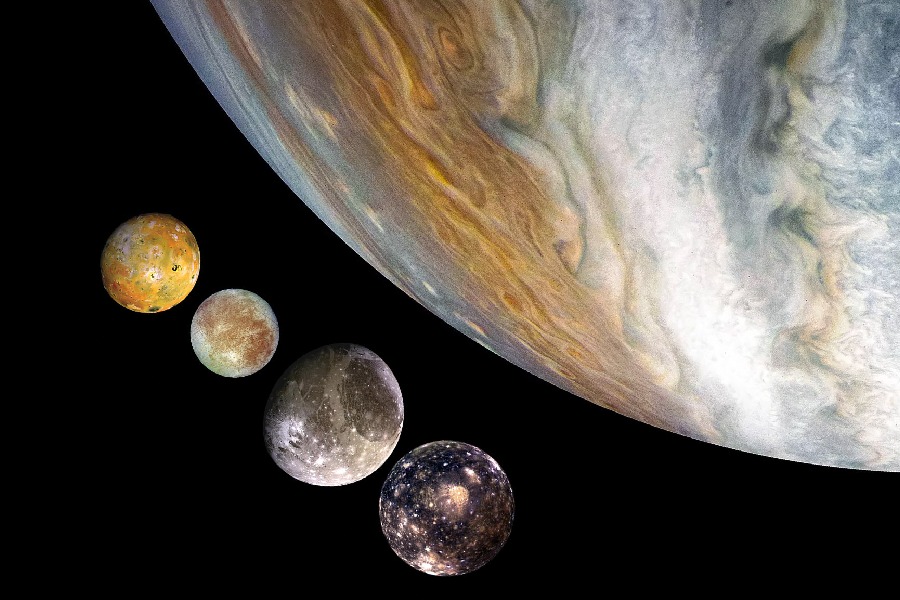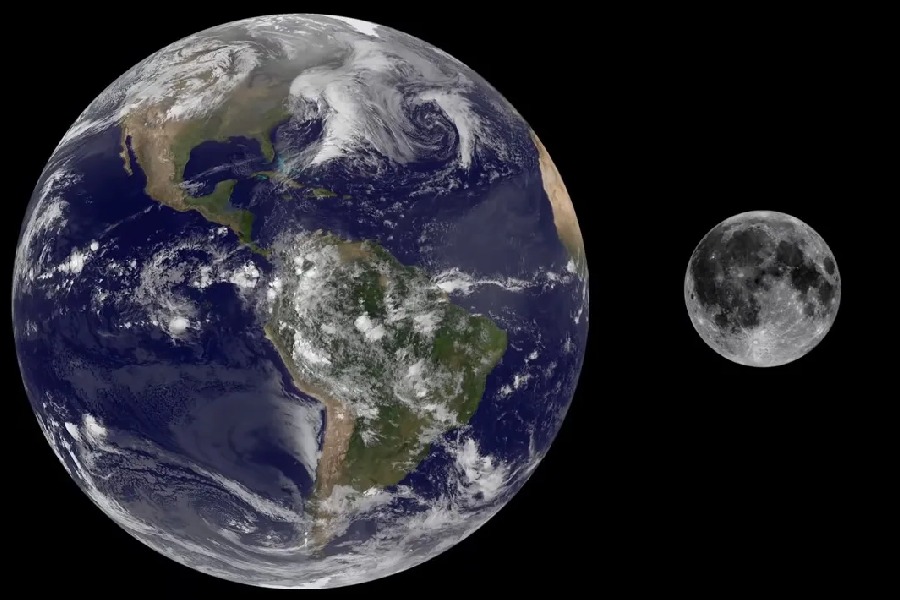Jupiter’s diverse family of 95 moons provides an intriguing astronomical study right in our solar system’s backyard. From the icy Ganymede to the volcanic Io, these natural satellites display a remarkable range of attributes. But how exactly are Jupiter moons compared to Earth? In this article, we’ll explore the parallels and differences between Earth and the four largest Jovian moons – Io, Europa, Ganymede, and Callisto.
You’ll learn about their distinctive features, orbits, sizes, compositions, and potential habitability. We’ll uncover what we can deduce about internal structure and surface processes based on measurements of these cosmic spheres.
Along the way, you’ll gain insights into how studying Jupiter’s moons advances our understanding of planetary science and astronomy. The comparisons drawn with Earth illustrate our own planet’s uniqueness as well as the shared processes shaping rocky and icy worlds across the cosmos.

Jupiter Moons Compared To Earth
Jupiter, the largest planet in our solar system, boasts an extensive family of moons numbering at 95. In comparison, Earth has only one natural satellite, the Moon.
Jupiter’s moons vary significantly in size, with the four largest – Io, Europa, Ganymede, and Callisto – known as the Galilean moons. These moons are larger than Earth’s Moon and exhibit diverse features, including volcanic activity on Io and the potential for subsurface oceans on Europa.
Jupiter’s diverse and numerous moons provide a stark contrast to Earth’s singular moon, offering scientists valuable insights into the complexities of planetary satellite systems.
Key Differences between Jupiter’s Moons vs. Earth’s Moon
Size
Earth’s moon, commonly known as the Moon, is the fifth-largest moon in the Solar System and is relatively large compared to other moons in the solar system.
Although Jupiter’s moons vary significantly in size, the four largest ones (Galilean moons) are much larger in size than the Earth’s moon. These are Io, Europa, Ganymede, and Callisto.
Orbital characteristics
Earth’s moon has a relatively circular orbit around Earth. Jupiter’s moons have diverse orbital characteristics. The Galilean moons have a combination of circular and slightly elliptical orbits and orbit Jupiter at different distances.
Io, the innermost of the Galilean moons, has a circular orbit with the shortest orbital period. In contrast, the outermost Galilean moon, Callisto, has a more elliptical orbit and takes about two weeks to complete one orbit around Jupiter.
Composition
Earth’s moon is composed mainly of silicate rock and metal, with a surface covered by regolith (a layer of loose, fragmented material).
Jupiter’s moons have diverse compositions. The Galilean moons consist of a mix of ice and rock, with variations in their surface features. For example, Europa has an icy crust with a subsurface ocean, while Io has active volcanoes.
Atmosphere
Earth’s moon has a very tenuous and practically nonexistent atmosphere. None of Jupiter’s moons have significant atmospheres, although some may have thin atmospheres composed of trace gases.
Surface Features
Earth’s moon has plains, craters, and mountains across its surface. The craters were formed by meteorite impacts over billions of years. There are also rilles, which are canyon-like features.
Jupiter’s moons have varied surfaces. Io is covered in active volcanoes due to tidal heating. Europa has an icy surface that may hide subsurface oceans underneath.
Ganymede displays a mix of grooved terrains and craters across its surface. Meanwhile, Callisto is heavily cratered, indicating the moon has been geologically inactive for billions of years.
Jupiter’s largest moons
Jupiter’s four largest moons are called the Galilean satellites. This refers to their discoverer Galileo Galilei. The Galilean moons include Io, Europa, Ganymede, and Callisto. They can be seen through binoculars or a telescope.
Galilean Satellites
These massive moons range from 1,930 to 5,268 km in diameter. They orbit between 400,000 to 1,880,000 km from Jupiter.
Diverse worlds
Each Galilean moon has unique characteristics despite their shared origins. Io is volcanically active. Europa likely has a subsurface ocean.
Ganymede is icy with possible liquid water. Callisto’s ancient surface is heavily cratered. Studying this diversity provides insights into planetary processes and solar system evolution.
Revealing Jupiter’s history
The Galilean moons shed light on Jupiter’s composition and formation mechanisms. Their orbits are indicative of gravitational influences over billions of years.
These massive satellites represent over 99% of the Jupiter system’s non-hydrogen and helium mass. The Galilean moons constitute a complex system of diverse worlds worthy of in-depth exploration.
Io– The Volcanic Moon
Io is Jupiter’s innermost Galilean moon. It is the most geologically active object in the solar system. Io experiences intense volcanic activity in the form of hundreds of active volcanoes.
Plumes and lava lakes create a dynamic surface. This extreme volcanism results from tidal heating caused by Jupiter’s gravitational forces. Io is essentially turning itself inside out.

Geological wonders
Io’s dramatic surface is coated with colorful sulfur compounds from its volcanoes. Surface features include lava flows, calderas, mountains, and swirling lava lakes.
Some lava can erupt hundreds of kilometers high. Studying Io’s geology provides insights into internal planetary heating mechanisms. Its volcanism makes it a standout among the Galilean satellites.
Electrifying interactions
Io has a tenuous sulfur dioxide atmosphere that collapses and reforms periodically. Electrical currents connect Io with Jupiter through an ionized plasma torus.
This generates brilliant auroras around Io’s poles. Io demonstrates the remarkable interactions and energy exchange within Jupiter’s diverse moons system.
Europa– An Icy Ocean Moon
Europa is slightly smaller than Earth’s moon. It is primarily composed of silicate rock and has an outer layer of water ice. Its surface is one of the smoothest in the solar system.
It has few craters but many crisscrossing grooves and ridges. A global saltwater ocean exists beneath the icy crust. This ocean can be over 100 km deep and contains more water than Earth.
Potential habitability
Europa’s hidden ocean has drawn enthusiasm for the prospect of life. Tidal heating from Jupiter provides energy. Nutrient-rich hydrothermal vents may exist on the seafloor. Exploring environments analogous to Europa expands understanding of astrobiology and habitability.
Challenges for exploration
The icy crust could be over 20 km thick. This presents challenges for studying the subsurface ocean. Future missions to sample plumes may uncover ocean material.
Landing probes will require sophisticated preparations. Europa represents one of our best chances of finding extraterrestrial life. Its subsurface sea compels further exploration.
Callisto– Heavily Cratered Surface
As the outermost of Jupiter’s four Galilean moons, Callisto orbits at an average distance of over 1.8 million km. With a diameter of 4,800 km, it is the third largest moon in the Jupiter system.
Callisto’s ancient cratered landscape is the oldest and most heavily bombarded surface documented in the entire Solar System so far.
The impact craters and eroded multi-ring structures that cover Callisto provide a record of bombardment from comets, asteroids, and other projectiles over the eons. The surface essentially preserves eons of impact history since the early formation of the Jupiter system and solar system.
Icy composition
Callisto also has an extremely tenuous atmosphere composed of carbon dioxide that was detected through trace amounts slowly escaping the surface.
Models of Callisto’s interior suggest a subsurface ocean layer may have existed early in its history but is now likely completely frozen solid. The lack of current tidal heating from Jupiter due to its distant orbit has allowed Callisto’s old, preserved surface to remain intact.
Magnetic Field and Rocky Mantle
The interiors of the Galilean moons showcase a diversity of structures and processes. Io, the innermost, experiences extreme tidal heating from Jupiter that results in over 400 active volcanoes across its surface and helps maintain a molten iron core surrounded by a rocky mantle.
A tenuous sulfur dioxide atmosphere forms from this intense volcanic outgassing. Europa possesses a global subsurface ocean under an icy crust that is heated to a liquid state by tidal forces, with the potential chemistry and energy to support life.
Impact on Tidal Heating
Ganymede’s liquid iron core generates an intrinsic magnetic field through convection. This interacts with Jupiter’s field above rock and ice crust layers containing ancient heavy cratering. Callisto avoids major tidal effects, preserving eons of impact history across its frozen surface and interior ocean.
Io encounters the strongest tidal forces, which continuously deform its rocky mantle to supply magma for over 400 active volcanoes. Jupiter’s gravity powers constant resurfacing and ash eruptions into space from this volcanic moon.
Europa experiences cyclical tidal stretching of its subsurface ocean, slowly cracking the icy surface and bringing oceanic fluid up from below. Occasional cryovolcanic plumes burst through as Europa’s hidden waters ripple from its gravitational dance with Jupiter.
Icy Surface and Biggest Moons
The Galilean moons are Jupiter’s largest satellites. Ranging from 3,100 to over 5,000 kilometers in diameter, their substantial sizes have allowed internal differentiation despite the outer space cold. All four Galileans formed primarily from water ice surrounding dense cores, with thin frozen crusts likely overlaying buried oceans.
Io’s extreme volcanism masks its fundamentally icy nature under continuously recycled surface ash. But atmospheric collapse restores Io’s icy identity as yellow surface sulfur deposits sputter away.
Europa clearly showcases an icy composition through its fractured bright terrain as its hidden ocean churns. Ganymede’s mix of cratered highlands and odd-grooved areas exhibits dirty surface ice coated by dark contaminants.
On mountainous Callisto, bright icy domes contrast with the older ice terrain. The Galileans thus share immense sizes and abundant surface ice overlying complex interiors.
Comparative Size of the Largest Moons
The Galilean moons represent the largest satellites in the solar system, with Ganymede as the giant exceeding even Mercury at over 5,200 kilometers wide. Its massive size hints at complex internal geologic activity over time.
Callisto follows at 4,800 kilometers, comparable to the dwarf planet Ceres, with an ancient pockmarked surface recording early outer solar system impacts. Europa is smaller at 3,100 kilometers across, allowing quicker development of its hidden global ocean kept liquid by tidal heating.
Tiny Io still reaches 3,600 kilometers wide, close enough to Jupiter to keep its interior melted and feed rampant volcanism. So the Galileans each showcase unique stories and scales while sharing immense size circling gas giant Jupiter.

Conclusion
The Galilean moons Io, Europa, Ganymede, and Callisto each possess unique characteristics and processes related to their immense sizes and tidal heating from Jupiter.
From Io’s rampant volcanism to Europa’s hidden ocean to Ganymede’s intrinsic magnetism and Callisto’s heavily cratered surface, the diversity of these Jupiter moons compared To Earth is astonishing.
Yet similarities exist too in their differentiation, icy surfaces, and status as the largest satellites circling the ruling gas giant. We hope this analysis has shed light on the scale and dynamics of the Jupiter system its four giant moons exemplify.
Their otherworldly natures showcase how our Earth, while special, resides amidst a sea of geologic possibility in our solar neighborhood. This article aimed to advance your perspective on that reality.
